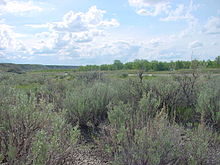- Artemisia cana
-
Artemisia cana 
Silver sagebrush in Dinosaur Provincial Park Scientific classification Kingdom: Plantae (unranked): Angiosperms (unranked): Eudicots (unranked): Asterids Order: Asterales Family: Asteraceae Genus: Artemisia Species: A. cana Binomial name Artemisia cana
Pursh [1]Subspecies Artemisia cana is a species of sagebrush native to western and central North America, having three subspecies.[3] It known by many common names, including silver sagebrush,[2][3] sticky sagebrush, silver wormwood,[2] hoary sagebrush, and dwarf sagebrush.[3] While these names apply to the species in general, there are others for each subspecies: plains silver sagebrush applies only to the autonymous subspecies Artemisia cana subsp. cana; Bolander silver sagebrush applies to A. c. subsp. bolanderi; and mountain silver sagebrush applies to A. c. subsp. viscidula.[3] The type specimen was described informally by its collector, Meriwether Lewis (collected on October 1st 1804, in the vicinity of Centinel Creek in South Dakota, during the epic Lewis and Clark Expedition), in the following passage from Original Journals of Lewis and Clark, edited by Thwaites in 1904 :
"On these hills many aromatic herbs are seen; resembling in taste, smel [ sic ] and appearance, the sage, hysop, wormwood, southernwood and two other herbs which are strangers to me the one resembling the camphor in taste and smell, rising to the hight of 2 or 3 feet; the other about the same size, has a long narrow, smo[o]th, soft leaf of an agreeable smel [ sic ] and flavor; of this last the A[n]telope is very fond; they feed on it, and perfume the hair of their foreheads and necks with it by rubing [ sic ] against it." [6]
Silver sagebrush is an aromatic shrub found in grasslands, floodplains and montane forests.[7] It generally reaches 50-150cm in height, with examples west of the Continental Divide typically being shorter than those east of the divide.[8] The leaves have a narrow blade shape, are evergreen, grey-green in colour, and have a distinct aroma.[8]
Artemisia cana is native to the Canadian provinces of British Columbia, Alberta, Saskatchewan and Manitoba and the American states of Alaska, Oregon, California, Idaho, Nevada, Utah, Arizona, Wyoming, Colorado, New Mexico, North and South Dakota, Nebraska and Minnesota.[2][9]
References
- ^ Artemisia cana was first described and published in Flora Americae Septentrionalis; or, a Systematic Arrangement and Description of the Plants of North America 2: 521. 1813 "Plant Name Details for Artemisia cana". IPNI. http://www.ipni.org:80/ipni/idPlantNameSearch.do?id=179304-1. Retrieved August 15, 2011.
- ^ a b c d Original Publication GRIN (July 16, 2008). "Artemisia cana information from NPGS/GRIN". Taxonomy for Plants. National Germplasm Resources Laboratory, Beltsville, Maryland: USDA, ARS, National Genetic Resources Program. http://www.ars-grin.gov/cgi-bin/npgs/html/taxon.pl?70094. Retrieved August 15, 2011.
- ^ a b c d e Howard, Janet L. (2002). "Artemisia cana". Fire Effects Information System (online). Rocky Mountain Research Station, Fire Sciences Laboratory (Producer): USDA; Forest Service. http://www.fs.fed.us/database/feis/plants/shrub/artcan/all.html. Retrieved August 15, 2011.
Note: FEIS erroneously attributes authorship of A. c subsp. bolanderi to "(Gray) G.H.Ward" - the correct authorship goes to (A.Gray) G.H.Ward (the B & P abbreviation "Gray" refers to Samuel Frederick Gray, 1766–1828; "A.Gray" refers to Asa Gray, 1810–1888). The basionym of A. c subsp. bolanderi is Artemisia bolanderi, which was first described and published in 1883 (see the IPNI reference, below, for A. c. subsp. bolanderi). - ^ Artemisia cana subsp. bolanderi (basionym: A. bolanderi) was published in Contributions from the Dudley Herbarium of Stanford University. Stanford, California. 4: 192. 1953 "Plant Name Details for Artemisia cana subsp. bolanderi". IPNI. http://www.ipni.org:80/ipni/idPlantNameSearch.do?id=20564-2. Retrieved August 15, 2011.
- ^ Artemisia cana subsp. viscidula (basionym: A. c. var. viscidula) was published in Rhodora; Journal of the New England Botanical Club. Cambridge, Massachusetts 61: 84. 1959 "Plant Name Details for Artemisia cana subsp. viscidula". IPNI. http://www.ipni.org:80/ipni/idPlantNameSearch.do?id=20566-2. Retrieved August 15, 2011.
- ^ William Clark. Original Journals of Lewis and Clark,1804–6. Vol. 1, Part 2. p. 307. http://www.ucdp.uc.edu/lewisandclark/exhibits/botany/silver_sagebrush.asp. Retrieved August 15, 2011.
- ^ "NPIN: Artemisia cana (silver sagebrush)". http://www.wildflower.org/plants/result.php?id_plant=ARCA13. Retrieved 2010-08-16.
- ^ a b "Artemisia cana in Flora of North America @ efloras.org". http://www.efloras.org/florataxon.aspx?flora_id=1&taxon_id=220001129. Retrieved 2010-08-16.
- ^ "PLANTS Profile for Artemisia cana (silver sagebrush) - USDA PLANTS". http://plants.usda.gov/java/profile?symbol=ARCA13. Retrieved 2010-08-16.
Categories:- Asteraceae stubs
- Artemisia
- Plants described in 1813
- Flora of Canada
- Flora of the United States
- Flora of the Plains-Midwest (United States)
- Flora of the California desert regions
- Flora of the Great Basin desert region
- Flora of Nevada
- Flora of New Mexico
- Flora of Arizona
- Flora of Utah
- Flora of Colorado
- Flora of Idaho
- Flora of Montana
- Flora of Oregon
- Flora of Wyoming
- Flora of Alberta
- Flora of British Columbia
- Flora of Saskatchewan
- Flora of Manitoba
- Flora of Alaska
- Flora of Minnesota
- Flora of Nebraska
- Flora of North Dakota
- Flora of South Dakota
Wikimedia Foundation. 2010.
